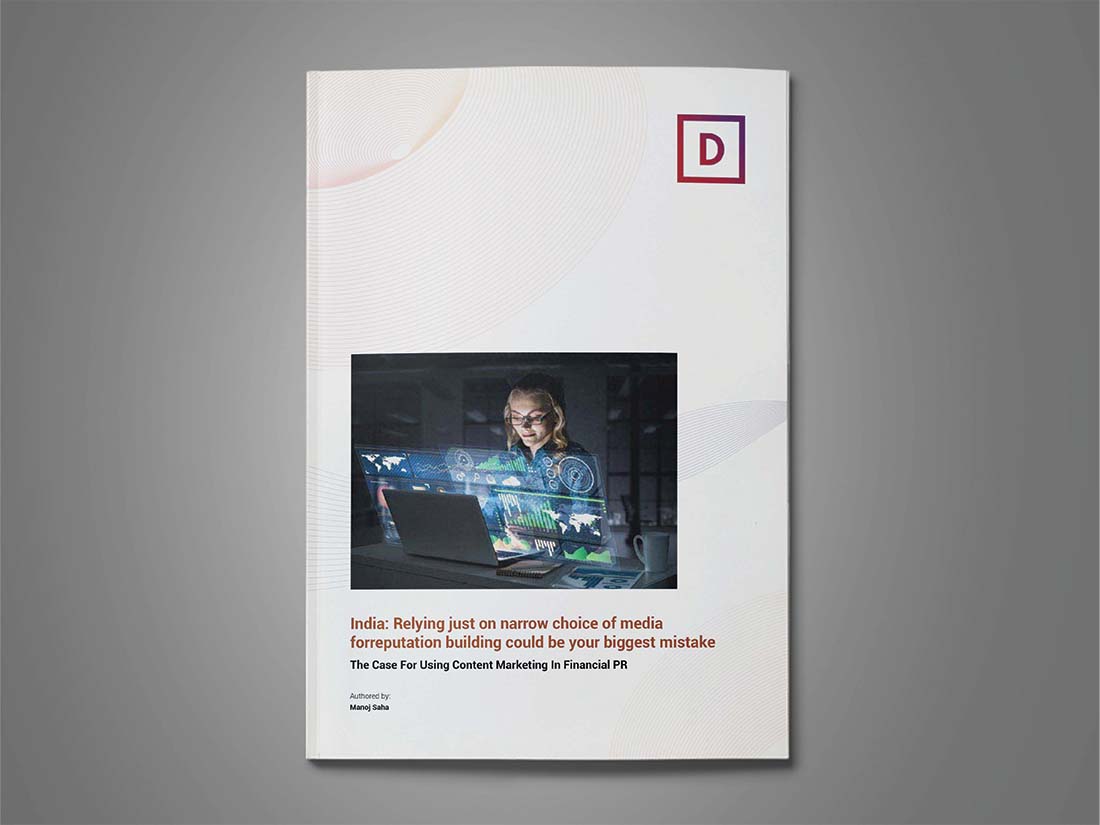The Case For Using Content Marketing In Financial PR
India: Relying just on narrow choice of media for reputation building could be your biggest mistake
Business communication is geared towards building formidable reputation and create value for all stakeholders. The consumers of this communication are savvy audiences, comprising investors, analysts, business partners, lenders and creditors, regulators & the rating agencies, and the talent. Ensuring that your communication reaches the right audiences and remain available forever for their consumption is critical for its efficacy. Corporates of sizes and shapes must seriously embrace contemporary reputation marketing strategies in order to be better understood and widely admired.
Google has changed everything!
Lionel Barber, editor of the Financial Times, in his speech for the annual James Cameron Memorial Lecture on November 22, 2018 at City University (Transcript available on www.ft.com), London made a point about growth of PR compared to the decline of newsrooms. He highlighted the rise of native content and the rising trend of in-house content creation and distribution. “Why engage with real journalists when someone browsing the web is just as likely to find your “story” when they Google your company’s name?” said Mr. Barber echoing the prevalent trend.
Is Print really the answer in India for reputation building?
Let’s look at some facts about India’s print media.
As per Indian Readership Survey (IRS) Q1 2019 by Media Research Users Council (MRUC), the print dailies have added 1.8 crore additional readers since IRS 2017. Of these additional 1.8 crore readers, interestingly, Hindi dailies have added 1 crore readers, whereas English dailies have added barely 0.3 crore readers since 2017. Internet, during this period, has seen the sharpest increase in reach among all the medium.
According to a report by Magna Global, a division of media agency group IPG Mediabrands, print media ad revenues in India grew 5.6% in 2018 to Rs 22,121.8 crore (US$ 3.16 billion), and it is expected to go up to Rs 22,424.3 crore (US$ 3.21 billion) in 2019. The report highlights that India is the only market in the world where print continues to be dominant and is growing in all aspects — circulation, readership and geography. However, the report also highlights certain crucial facts. For one, most of the revenue growth is attributed to strong growth in readership and circulation of language (non-English) newspapers. Two, English newspapers, facing competition from digital platforms, have seen a drop in readership growth rate. Three, Digital advertising will lead with 32.8% growth in 2019.
Now these scenarios present a kind of contradiction. It is well documented that print media globally is on a decline, whereas in India it is thriving. However, it is the non-English media that is thriving and their readership is far wider than that of English media readership. This is a good reason for advertisers to continue allocate a larger pie of the ad spend to print. However, what does this mean for Corporate Communicators? For business communication, even in India, English is a prominent language, and given the fact that English print media readership is on a decline, do business communicators have a different strategy for wider outreach?
“It’s time for a whole new approach to content development and dissemination, with clear reputation building objectives.”
Digitalisation and Information Suffrage
As seen in most cases, developing countries eventually catch up on the global trend of digital information consumption, seen in the developed countries. Business communication is no different. With smart phones in every hand, search for even business news will be prominent on devices than on parchments. While the world is moving towards content marketing, influencer targeting and creating compelling stories that have power of persuasion, Indian businesses’ continued obsession for print media coverage is inexplicable.
With the proliferation of digital devices, corporates have much more freedom to be ‘found’ on the digital domains – on their own terms – and not on any media house or journo’s terms. It is time a whole new approach to content development and dissemination strategy had to be thought out with top-down approach across organisational structures – with clear reputation building objectives. Reputation custodians must be seized with the idea of widening the stakeholder outreach with novel content marketing techniques, rather than feeling deprived of often out-of-context mentions in business media, which tend to be brief, occasional, and highly redacted.
“While content marketing can take time to show real results, it is a strong, long-term approach to improving one’s brand visibility.”
Leveraging Content Marketing
Business communication is geared towards building formidable reputation and letting each stakeholder know how an organisation is creating value for them. The consumers of this communication are savvy audiences comprising investors, analysts, business partners, lenders & creditors, regulators & the rating agencies, and the talent. Ensuring that your communication reaches the right audiences and remain available forever for their consumption is critical for its efficacy. Corporate India must embrace contemporary reputation marketing strategies in order to be better understood and widely admired.
This blog is not about the benefits of Content Marketing (which will be treated in a separate one), but more about the growing ineffectiveness of print media for corporate reputation building. Without a doubt, content marketing, done correctly, can produce dramatic results for your business reputation. But, it takes time and focus to become effective at it. If companies can develop an effective strategy for creating content based on proper understanding of their target stakeholders, including investors, they’ll be quite effective at opinion shaping. With content marketing, you’re giving valuable information away before asking people for anything. Your existing and prospective investors will usually be happy you did, because they feel more valued and understood. While content marketing can take time to show real results, it is a strong, long-term approach to improving one’s brand visibility. It also helps you nurture a stronger relationship with your stakeholders.
To know more on how to use Content Marketing Services, and bypass the inefficiencies of print media, to proactively shape opinion – connect with Dickenson to know more.

The Case For Using Content Marketing In Financial PR
To download and save this article.
Authored by:


Leave A Comment